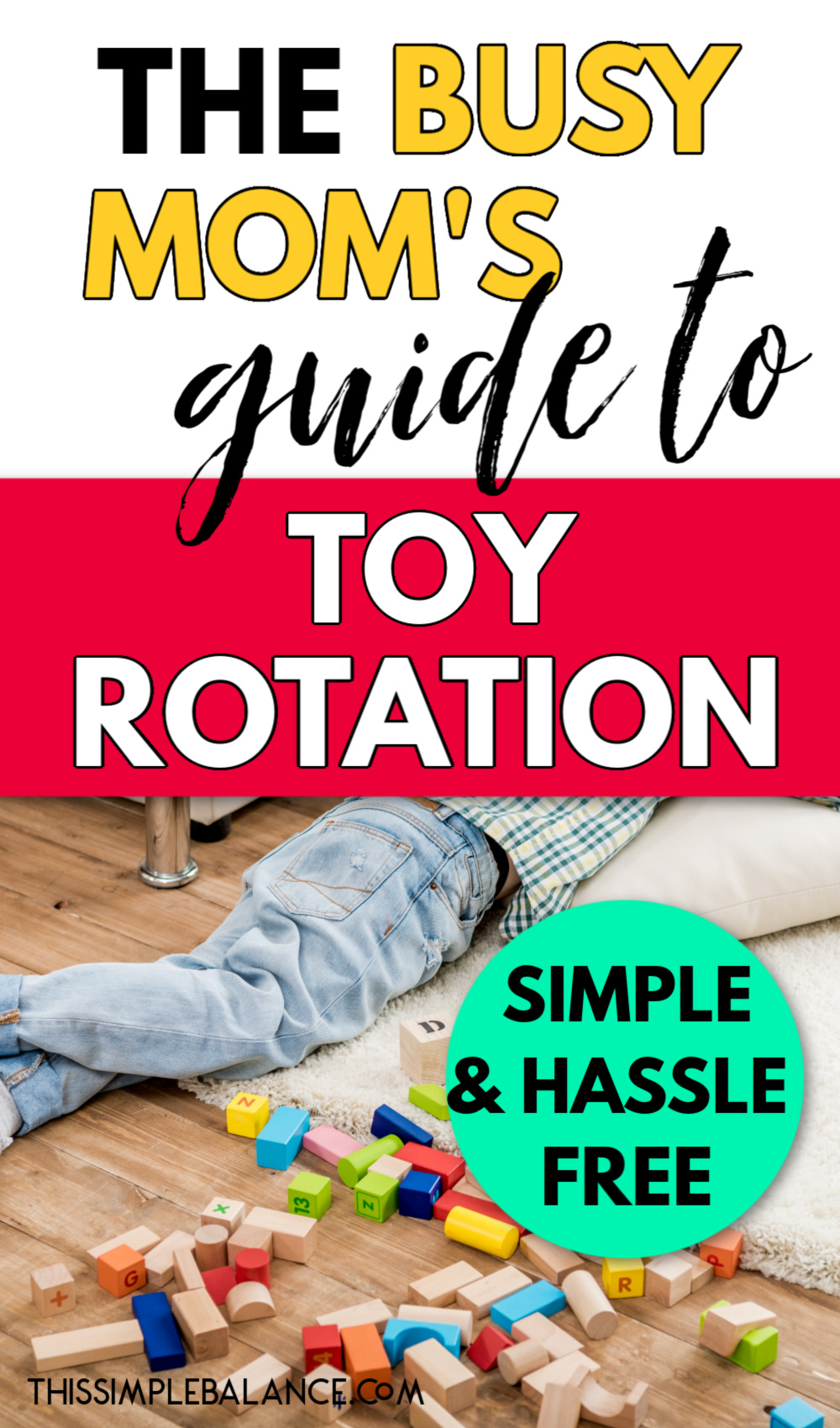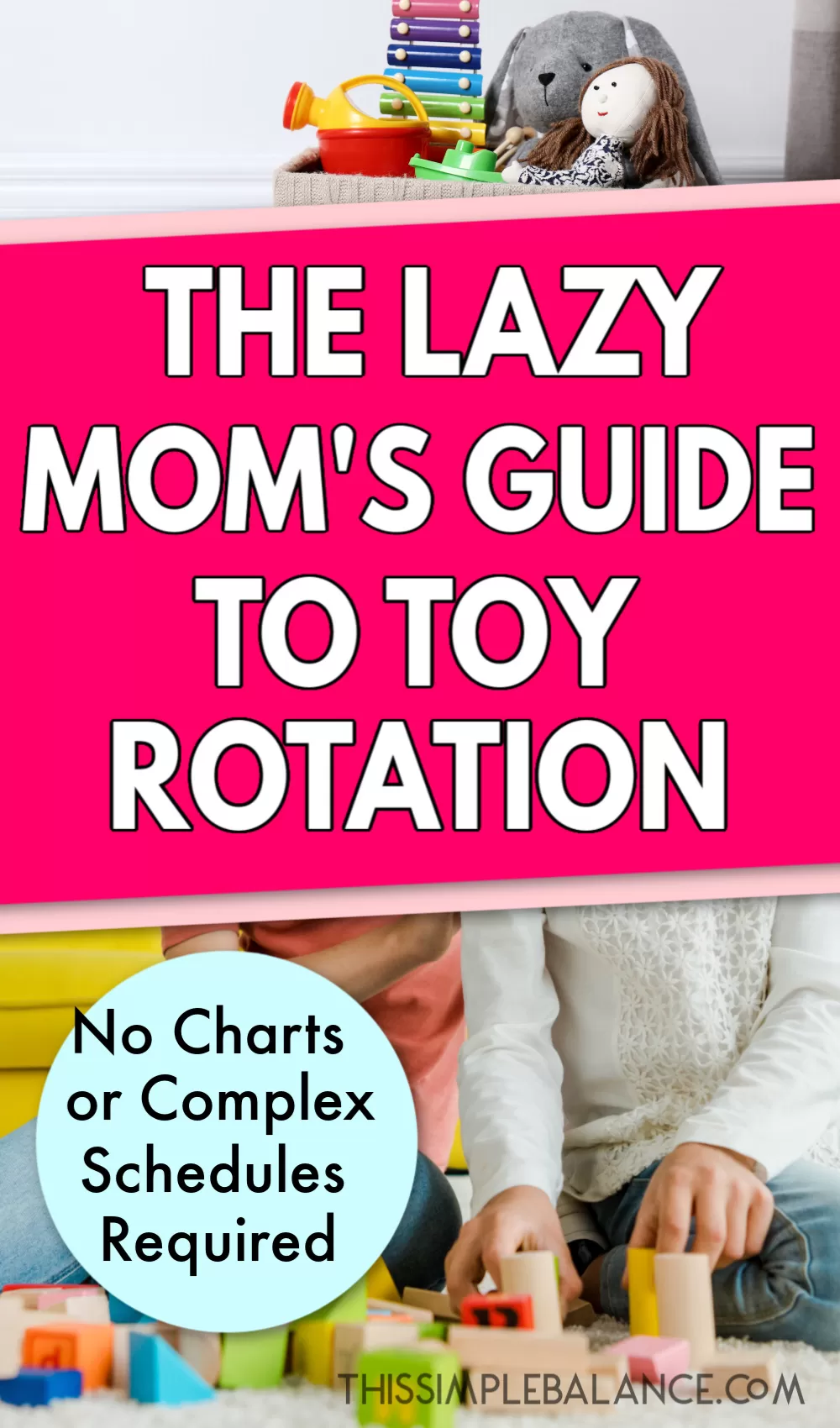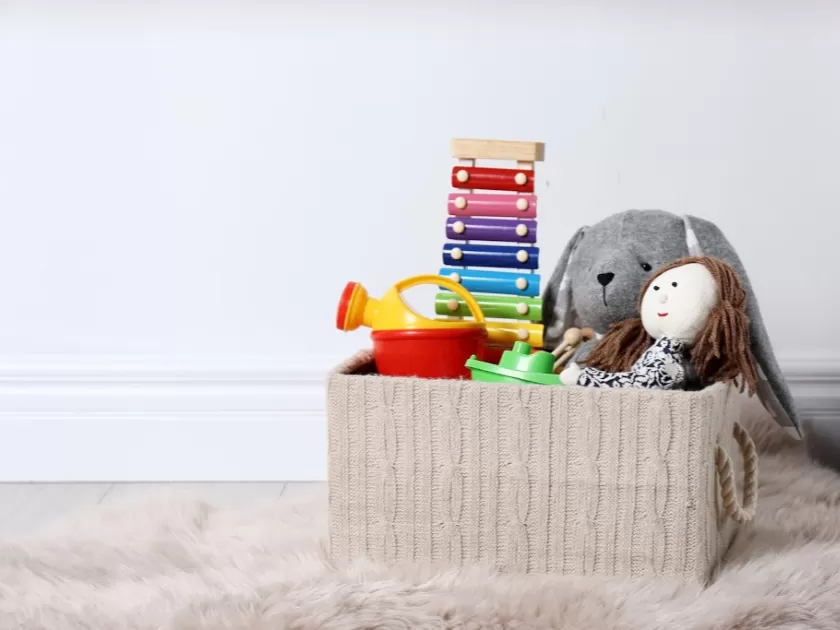Inside: Toy rotation is a genius way to cut down on toy clutter without getting rid of more toys (assuming you’ve already decluttered the toys). But you don’t need a complicated toy rotation system to make it work – try this ridiculously simple approach, instead!
When you’re inundated with toys most moms I know have decluttering on the brain. Ell me I’m not the only mom who had a minor panic attack watching even our relatively small pile of presents being opened?
Toy clutter is the WORST. Right up with knick-knack clutter, in my opinion.
In a lot of cases, I would generally encourage decluttering the toys again.
But if you’ve already done that – you’re keeping the toys you truly want – and the toys STILL feel overwhelming, toy rotation is something you definitely want to consider implementing ASAP.
Related: The Best Minimalist Toys for Hours of Happy Play
The Stupid Simple Toy Rotation System Is Born
THIS POST PROBABLY CONTAINS AFFILIATE LINKS. AS AN AMAZON ASSOCIATE, I EARN FROM QUALIFYING PURCHASES. YOU CAN READ OUR FULL DISCLOSURE POLICY HERE.
At the time of this writing, we live in a less than 1200 square foot house with 2 adults and 5 kids. We also homeschool, which means we’re home all day every day.
I keep more toys than the average minimalist family because I want the variety, plus I use them as part of our homeschool day. The toys we do have, the kids play with fairly regularly and want to keep (this after multiple rounds of decluttering).
But we definitely have more toys than I want out and available to the kids all day, especially in our small space.
Dilemmas. Dilemmas.
A while back, I tried a toy checkout system to manage the toy clutter. It worked great! For about a week, maybe two.
The main problem? A toy checkout system was MUCH too high maintenance for me. Or for any mom with more than two kids, in my opinion.
I vaguely remembered a good friend who used some kind of toy rotation system, so I decided to look into toy rotation.
But the more I researched toy rotation, the more I realized that the toy rotation systems many moms recommend are SO dang complicated!
They came with schedules and fancy printables and making sure there was a category of each kind of toy out at a time.
#aintnobodygottimeforthat
I don’t have time for that, and I’m betting you don’t either.
So I’m going to share with you the ridiculously simple approach to toy rotation I came up with a few months ago.
It’s so simple, it will blow your mind.
Related: 12 Tips to Keep a Clean House with Kids (from a mom of 5)

Toy Rotation: 5 Simple Steps to Get Started
1. Gather the toys.
Get all the toys in one place, except bigger things like ride-on toys and play kitchens.
2. Gather bins and baskets.
Grab all your baskets and bins you want to use for toy rotation.
Most families who want to implement a toy rotation system probably don’t need more storage containers.
But on the off chance you do, I recommend:
- Cheap Baskets at Thrift Stores
- Cheap, 6 Quart Bins with Lids, like THESE
The clear bins make it easy to stack and see everything all together.
Bigger bins can hold things like DUPLO blocks and dress up (a rolling coat rack like this one could work well for dress up, too).
3. Group toys into like categories and put into separate bins.
Little people and other figures go in one bin.
Magnatiles in another.
Marble run in another.
You get the idea.
4. Choose 2-4 groups of toys to keep out for the first round of toy rotation.
Put the rest of the toys in a storage room or closet.
5. When you notice your kids are playing with the current toys less and less, swap them out for new ones.
I have a few IKEA Kallax baskets in our family room. I’ll generally dump out whatever toys are in a basket and put that toy away in the clear bin (which goes back to storage).
The new toy goes into the Kallax basket.
I also usually have one of the clear plastic bins out at a time. In that case, I simply swap one for the other.
Side Note: If you’re still considering toy storage, opt for clear bins or shallow baskets. For kids, if they can’t SEE the toys, they don’t really exist to them. Really. If they can see the toys, they are far more likely to be played with.
Simple Toy Rotation Should Make Your Life Easier
Voila. Done.
No charts. No strict “switch out this toy category every week and this one every other week.”
I really don’t have time or energy for that.
Plus, there’s a million things I’d rather be doing that managing the toys. Just sayin’.
BUT.
Toy rotation should make your life better.
Toys are fresh every week or so, so theoretically, they should play more + better. There’s also less to clean up.
Now if only we had a stupid simple method for sibling fighting, we’d be golden.
Common Toy Rotation FAQs
Here are answers to commonly asked questions, in no particular order.
Q: What if my child asks for a specific toy that’s not out in this toy rotation?
Don’t be a stickler. Give your child the toy.
Put away one set of toys in exchange if the toys are overwhelming.
Simple.
Q: If you need a toy rotation, shouldn’t you get rid of more toys?
You could. Or not.
It’s really up to you.
Every family is going to have a certain toy clutter threshold. So much depends on family size, if you’re home all day, house size, etc.
As I already mentioned, I choose to keep the amount we have because:
- Family size
- Home all day
I also have the space to store the excess toys not currently in rotation. If I didn’t have anywhere to put them, I’d probably reconsider decluttering the toys again.
Basically: you do you. If you want to declutter more, please do!
Q: Shouldn’t you keep track of which toys are out when, so the toy rotation works best?
Ummm…you can. But again, writing things down. Time.
Yeah, no.
Toy rotation should make your life easier, not harder. But that’s just my opinion.
I have enough to keep track of, so I skip all the tracking.
But if it makes you feel awesome about the toys you’re keeping, then do it!
Q: What if a particular toy still isn’t getting played with, even when it’s rotated?
It’s probably time for that toy to find a new home.
Great places to donate toys in decent condition:
- Doctor’s Offices
- Facebook Marketplace
- Buy/Nothing Groups
- Friends (you could swap)
Just make sure to ask your kids first. Explain to them that you noticed they don’t play with it anymore. Give them a week to see for themselves that they really aren’t interested.
Then declutter those toys!
Related: The Biggest Mistake to AVOID When Decluttering with Kids
Q: Why is toy rotation a good idea?
Kids stop truly seeing things in their environment when they become accustomed to seeing it every single day. Everything sort of blends in.
When you do toy rotation, things become novel again because you’re constantly changing the environment.
It works even better if you have open shelves and clear containers. Or if you can “strew” them one morning out in the open or leave them out on a coffee table for them to discover.
I’ll reiterate that when things are in baskets, kids literally forget they’re there. If you have the option, choose clear, shallow bins or wire see-through baskets list these for toys.
Q: How often should you rotate the toys in your toy rotation?
As often as you feel like the old ones are getting “stale”.
For us, I swap them out every 1-2 weeks.
Q: Do you keep any toys out all the time?
LEGOs are out in the boys’ room 24/7.
Each child has 1-3 stuffed animals out on their beds all the time. My rule with stuffed animals is if they stay on the bed, they can keep them. Stuffed animal clutter drives me CRAZY.
Art supplies are also out all the time.
The rest of the toys are in constant rotation.
Q: What about electronic toys? Should they be in rotation?
I have a friend who keeps “any toy that makes noise” away except for times of dire need:
- Parents are sick.
- Kids are sick.
- Work deadlines.
We have very few electronic toys, but I do tend to save them for what I truly need them!
I hope that answers all your questions about toy rotation, but if you have an unanswered question, leave it in the comments and I’ll add answers to this post!
Do you do toy rotation? Share your tips and wisdom in the comments!



This is exactly what I needed. You’re totally right about all the other ones being too complicated and time consuming! Thank you very much for the tips. Can’t wait to get this started and declutter not only my home but my mind too.
This is perfect!!!! I think im going to group to together different types( some building toy, a few cars, a puzzle and buzz) of toys in one larger bins and rotate like how you explained. Im going to also put playdoh, paints and Legos in their own containers for my older one..
So glad it was helpful for you Alaesa!
I have tried to implement toy rotation, as we also have lots of kids in a small house. But it has never really worked like I envisioned. So instead we do this. FIRST, we decluttered all the toys. If the toys do not fit in their designated location or bin, it is time to downsize again! Since we always have a baby or young toddler in the house, all toys and games with little pieces or that are messy go into clear plastic bins, and are stacked on shelves in a closet. The kids know that these can come out one at a time, but then must be picked up completely, and put away before a different bin can come out. These include things like Play-Doh, Lincoln Logs, Magna tiles, paints, Legos / Duplo blocks, beads, Etc. In our living room, on a small shelf, I keep a bin of baby toys, along with all of our Green Toys cars, trucks, and planes. We have a small wooden shelf in the kids bedroom, which holds wooden bins that contain toys that are safe for everyone, such as wooden blocks , balls, wooden trains, Etc. In our basement, my husband laid down a strip of carpet remnant, which is where the bigger toys and their accessories are located, such as the play kitchen set, and accompanying accoutrements (in fabric storage bin on shelf) and Little People sets (in plastic totes/wooden toy box). We also have a little plastic Little Tikes or Step 2-type climbing toy with slide (that a customer of my husband’s gave him for free) – there are very long winters where we live. So I basically try to keep the upstairs toys very minimal, and baby safe, while downstairs toys can get a little more crazy, and is where the kids go to play when there are neighborhood kids or friends over.
great tips Savannah! Thanks for sharing what’s worked for you.